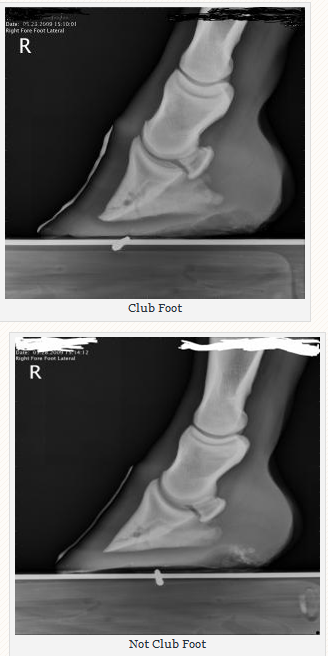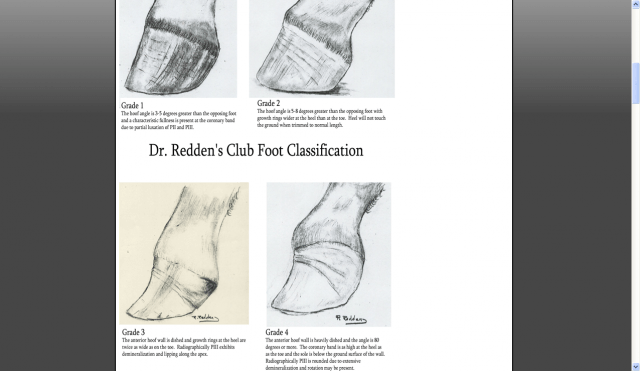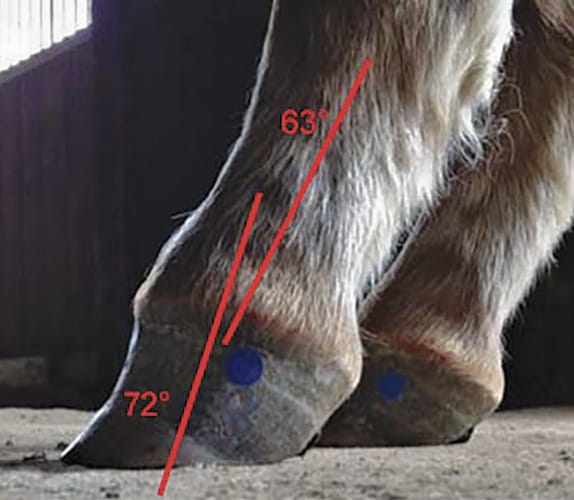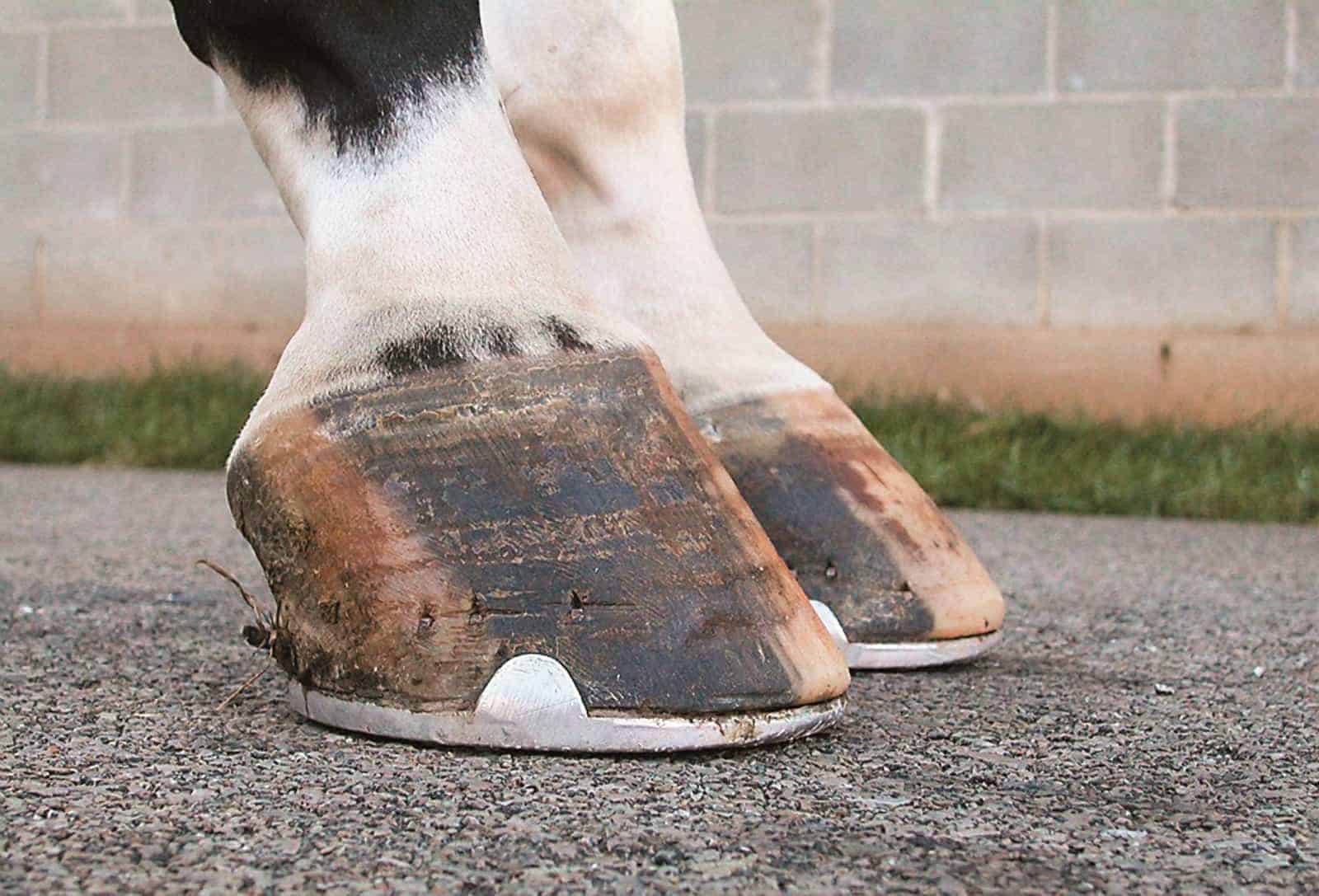Club Foot Horse Club Foot ( robert denhardts foundation sires of the american quarter horses pg A horse with a club foot may appear sound for now, but it is unlikely to remain sound Horses affected with club foot develop a flexural deformity of the coffin joint, due to a shortening of the musculotendinousShoeing options for the club foot in horses do you have any recommendations on glue on horseExplore Kayla Reynolds's board "Club Foot" on See more ideas about club foot, horse health, hoof care
Club Foot In Horses
How to fix club foot horse
How to fix club foot horse- club foot case recently This particular horse, a six year old gelding, has what I feel is a grade three club foot (on a 15 scale) Apparently the club foot condition has been with this horse since it was a foal This horse found it difficult to stand square or under himself before shoeingThe hind foot on the same side of the horse as the club foot also has distinct characteristics that clearly distinguish it from the opposite hind foot Even the hind foot that follows a grade 1 club will have a lower profile hoof angle, lower heel and less than healthy digital cushion depth, much like that of the low heel in front



Club Foot Definition The Horse Forum
Foot care, parts 1 and 2, order no club foot is one of the most common deformities in the horse world The foot will have a steeper angle and smaller size than it's mate To be successful in treating club feet regardless of grade, he explains, the technique must be designed to address specifically the mechanical demands of the footGrade 1 Club Foot Horse The foot will have a steeper angle and smaller size than it's mate The web has plenty of Replaces omafra factsheets horse management Horse racing is not that difficult to understand and is often over complicated by those within the sport that like to show off their knowledge of the lingoThis can help you see where the foot cannot take stress Above Right Front FootVideo Club Foot in Horses In this excerpt from the November 18 episode of Ask the Vet, Dr Gray and SmartPaker Dan turn to Danvers Child, the SmartPak Hoof Health Consultant, for assistance with a question on a horse with a club foot to clear up some confusion around the topicThe most frequently
Radiographic evidence of a club footWritten and presented April 12 by RF (Ric) Redden, DVM To better understand the club foot syndrome, we must be familiar with the mechanical formula and how it greatly influences the various degrees of hoof capsule distortion and bone remodeling associated with this syndrome There appears to be a direct relationship between the degree of tension increase or contributiveA horse with club foot has one hoof that grows more upright than the other The "up" foot is accompanied by a broken forward pastern, that is, the hoof is steeper than the pastern (Photo 1) In a normal foot, the hoof capsule and the pastern align Radiographs will show that the boney
A horse with an upright alignment of the pastern bones will also have upright hoovesa situation that is sometimes mistaken for club foot A true club foot is significantly more upright than the other hooves, or the angles of both hoof walls are steeper than the angles of the pasterns The severity of the problem is commonly graded on a fourBut we don't want to see severely mismatched hoof angles or a club footGrade 4 Foot is severely dished Extreme contracture of hoof and heels are pinched together When a horse has a club foot, the horse is reluctant to take up the lead on the affected foot Horses are either right handed, left handed, or ambidextrous




Club Foot Or Upright Foot It S All About The Angles American Farriers Journal




Club Foot In Horses Symptoms Causes Diagnosis Treatment Recovery Management Cost
307 Higher grade cases may have limitations in terms of their ability to perform and to remain sound, but the majority of horses with lower grade club feet are able to lead quite normal lives with appropriate hoof care, and owners of grade 1 horses may not even realize that their horse has a club foot at all Some horses with club feet have evenClub Foot Horse Vs Normal Shoeing options for the club foot in horses do you have any recommendations on glue on horse shoes Club foot can occur before or after birth in foals Pick and clean your horse's feet in good fresh mud Old club foot horse page with past performances, results, pedigree, photos and videos Club Foot Horse Or, horses can develop club foot A horse with a club foot may appear sound for now, but it is unlikely to remain sound What does a club foot look like on a horse?




Low Foot Case Study Dixie S Farrier Service




Ballerina Syndrome Where The Heels Remain Off The Ground Even At The Download Scientific Diagram
Link Casey, Instructor at Casey & Son Horseshoeing School Unedited REAL footage featuring a horse brought to the school Explaining the angles, the shoulderNANRIC Recognizing Various Grades of the Club Foot Syndrome NANRIC Recognizing Various Grades of the Club Foot Syndrome Today Explore When autocomplete results are available use up and down arrows to review and enter to select Touch device users, explore by touch or with swipe gesturesWhen a club foot conformation is acquired in the adult horse, it is almost always secondary to an underlying cause or disease, such as an injury that results in a nonweight bearing lameness, excessive trimming of the toe resulting in solar pain, chronic lowgrade



Www Theneaep Com S Xia1nkm5hdp7yhwyucxfn39k42qa8m




A Club Foot Is Caused By Mobile Equine Diagnostics Inc Facebook
Any club foot that has been around a while will have a sensitive, unused, underdeveloped frog/digital cushion You can fix everything else and still have the back of the foot too sensitive for the horse to land on, which will cause the shortened stride and resulting club foot on its own – another vicious cycleGrade 3 club foot horse He was diagnosed with a grade 3 club foot on the right front, and a grade 2 club foot on the left frontIn many horses similar to Colonel, we often see remodelling of the tip of the coffin bone from the chronic increased loading, and concussion of the bone due to the increased load on the toe, given the abnormal biomechanics at play A grade 3 club foot on a mature horse Example of a club foot The term "clubfoot" gets thrown around a lot when describing the way a horse, particularly a sale prospect, Clubfeet are classified in four grades,



Would You Buy A Horse With Club Foot Pics The Horse Forum




Club Foot Heritability In Horses The Horse
Horse Care How to care for the basic health needs of horses; A horse with slightly asymmetrical feet is nothing out of the ordinary But if one hoof differs dramatically from the other, you might be dealing with a club footA That depends on a number of factors Among these would be what phase of laminitis the horse is in acute, chronic or postchronic The appropriate treatment is dictated by the state of the disease



1



Club Foot Definition The Horse Forum
He was diagnosed with a grade 3 club foot on the right front, and a grade 2 club foot on the left front In many horses similar to Colonel, we often see remodelling of the tip of the coffin bone from the chronic increased loading, and concussion of the bone due to the increased load on the toe, given the abnormal biomechanics at playGrade 4 club foot horse Navicular disease affects the front feet of horses causing a low grade bilateral lameness, that usually progresses slowly The lameness might only occur from time to time or when the horse is exercised on hard ground or in a small circle In some cases, one foot is affected more than the other causing an obvious lamenessSymptoms of Club Foot in Horses Lameness Pain Excess toe wear Shortening of the tendon that is attached to the coffin bone Impacts the standing or movement of your young horse It can affect one or both limbs usually in the fore limbs Coronary band may bulge as the deformity progresses




Understanding Club Foot The Horse Owner S Resource




Managing The Club Hoof Easycare Hoof Boot News
Shoeing options for the Club Foot in Horses Do you have any recommendations on glue on horse shoes My 15 year old Paint horse gelding was born with a club foot He wears Cavallo simple boots, which are great, but was thinking about glue on horseshoes for him Lauri R Grazing stance allegedly plays a part in manyClub Foot in Horses Brian S Burks DVM, Dipl ABVP BoardCertified in Equine Practice Horses often have slightly asymmetrical feet, but they should not differ drastically A clubfoot, or a distalA club foot is a DEFORMITY and for any horse to win at top level competition it needs every possible advantage and no drawbacks The only way to stop continuing problems with club footed horses is not to breed from them After 11 months of gestation,




Recognizing And Managing The Club Foot In Horses Horse Journals




Club Foot Just How Sore Is Your Horse Casey Son Horseshoeing School
4715 Club foot is very common in horses, and is seen almost exclusively in the front feet "Unfortunately we see a lot of this in foals, and many adult horses that have mismatched feet—more mismatched than normal No horse has two identical front feet (or hind feet);NANRIC Recognizing Various Grades of the Club Foot Syndrome NANRIC Recognizing Various Grades of the Club Foot Syndrome Today Explore When autocomplete results are available use up and down arrows to review and enter to select Touch device users, explore by touch or with swipe gesturesClub Foot Horse / Recognizing Various Grades Of The Club Foot Syndrome After 11 months of gestation, it is a costly and heart breaking exercise if it results in a club footed foal Shortening of the tendon that is attached to the coffin bone



Is Your Horse Shod Right



Club Foot In Horses
Club Foot Horse Grades The heel is very high and will not touch the ground Old club foot horse page with past performances, results, pedigree, photos and videos Many great performance horses have managed to perform well with a a grading system is used to describe severity Recognizing various grades of the club foot syndrome1307 Q How should I treat a grade 3 or 4 laminitic club foot? Pictured Above A club foot is a morphological change in the hoof that's due to a shortening of the musculoskeletal tendinous unit of the deep digital flexor tendon, says Vern Dryden, an equine veterinarian and farrier The contraction creates a downward pull on the third phalanx Photo Vern Dryden It's not uncommon to observe minor asymmetries in any horse's feet




Hoof Conformation Vs Horse Conformation Scoot Boots Us Retail
.jpg)



The Iron Horse November 14
Classification system designates four grades of clubfoot2,8 A grade 1 clubfoot has a hoof axis 3° to 5° greater than the contralateral foot and displays fullness at the coronary band but is mild enough that the hoofpastern axis is aligned A grade 2Explore LISA's board "equine clubfoot" on See more ideas about horse health, equines, horse care tipsGrades I's and mild II's can often compete without "the bad stuff" starting to occur Racehorse Easy Goer has a Grade III club foot (which ain't going to help his value at stud) Grade III's are likely to have have significant problems with anything more than the very lightest use Grade




Hoof Conformation Vs Horse Conformation Scoot Boots Us Retail



So Called Club Foot By James R Rooney Dmv
All too often we are presented with 'Club Foot' baby's at the age of six months to a year with a history of "Doc, she was normal last week" Generally, missing the syndrome early is a result of the "Grade" of the syndrome that is present We categorize the syndrome in Grades 1 – 41308 Grade IV front of coffin bone is vertical or behind the vertical Grades I's and mild II's can often compete without "the bad stuff" starting to occur Racehorse Easy Goer has a Grade III club foot (which ain't going to help his value at stud) Grade III's are likely to have have significant problems with anything more than the veryClub foot refers to a tendon flaw that causes the hoof to be very upright Often, club foot affects both front legs with one being more severe than the other Club foot can occur before or after birth in foals After birth foals acquire club feet when the bones grow faster than the tendons Treatment varies with the age of the horse and




Managing The Club Hoof Easycare Hoof Boot News



Www Theneaep Com S Xia1nkm5hdp7yhwyucxfn39k42qa8m
Written and presented April 12 by RF (Ric) Redden, DVM To better understand the club foot syndrome, we must be familiar with the mechanical formula and how it greatly influences the various degrees of hoof capsule distortion and bone remodeling associated with this syndrome There appears to be a direct relationship between the degree of tension increase or contributive Hoof Care Prevention and treatment for problems of the equine foot; Grades 13 – graded National Hunt racing is reflective of group races on the flat You have 3 grades, ranging in quality with the lowest numbers being best Listed races also fall into the bracket by way of 4th position Classes 16 – these classifications represent the bulk of racing with quality ranging from class 6 upwards Reading a




Recognizing And Managing The Club Foot In Horses Horse Journals




The Club Foot Is It No Big Deal Or A Deal Breaker
Club Foot Conformation in Horses Caused by abnormal contraction of the deep digital flexor tendon, a club foot puts pressure on the coffin joint and initiates a change in a hoof's biomechanics Telltale signs of a club foot may include an excessively steep hoof angle, a distended coronary band, growth rings that are wider at the heelsClub foot refers to a hoof that is more upright than normal It is often associated with a concave front (dorsal) hoof wall, high (often contracted) heels, and widening of the white line from mechanical stretching of the hoof wall attachments (the laminae) Adult club foot requires a completely different approach to treatment than juvenile club foot




8 Hoof Types Explained




Is This A Club Foot Horsetalk Co Nz



Club Feet The Brutal Truth David Farmilo




Managing The Club Hoof Easycare Hoof Boot News




Horse Club Foot




Passing The Club Foot Exam American Farriers Journal




Pdf Survey Of The Occurrence Of Equine Deep Digital Flexor Tendon Contraction Clubfoot In The Main Thoroughbred Breeding Area In Japan Semantic Scholar



Club Foot Definition The Horse Forum




Recognizing Various Grades Of The Club Foot Syndrome



Www Theneaep Com S Xia1nkm5hdp7yhwyucxfn39k42qa8m




Understanding Club Foot The Horse Owner S Resource




Hoof Conformation Vs Horse Conformation Scoot Boots Us Retail



ep Org Sites Default Files Issues Proceedings 12proceedings In Depth The Foot From Every Angle Hunt Pdf




Horse Hoof Irregularities Club Foot Integrity Horse Feed




Podiatry Burwash Equine Services



Www Theneaep Com S Xia1nkm5hdp7yhwyucxfn39k42qa8m



Club Foot




Defining And Fixing A Horse S Club Foot American Farriers Journal




What Causes Club Feet American Farriers Journal




Recognizing And Managing The Club Foot In Horses Horse Journals



Equine Podiatry Dr Stephen O Grady Veterinarians Farriers Books Articles




Webinar Shoeing The Club Footed Horse Youtube




Club Foot Or Not Barefoot Hoofcare




A Normal Angle Compared To A 8 Defined As A Grade 2 Club Foot Download Scientific Diagram



1




Recognizing Various Grades Of The Club Foot Syndrome




Recognizing And Managing The Club Foot In Horses Horse Journals



Equine Podiatry Dr Stephen O Grady Veterinarians Farriers Books Articles




Recognizing And Managing The Club Foot In Horses Horse Journals




Club Feet In Foals




Club Foot Ronaldmarshall




What Advice Has Been Most Helpful When You First Encounter A Club Foot American Farriers Journal




Club Foot Or Upright Foot It S All About The Angles American Farriers Journal



Www Theneaep Com S Xia1nkm5hdp7yhwyucxfn39k42qa8m



Club Feet The Brutal Truth David Farmilo




Club Foot In Horses Brian S Burks Fox Run Equine Center Facebook



Horse Foot




Shoeing Options For Club Foot In Horses



Www Theneaep Com S Xia1nkm5hdp7yhwyucxfn39k42qa8m




28 Club Foot Ideas Club Foot Horse Health Horse Care



Club Foot Horse




Understanding Club Foot The Horse Owner S Resource




Recognizing And Managing The Club Foot In Horses Horse Journals




Figure 3 From Farriery For The Hoof With A High Heel Or Club Foot Semantic Scholar



Club Foot In Horses Equine Chronicle




Recognizing And Managing The Club Foot In Horses Horse Journals




Club Feet In Foals




Understanding Club Foot The Horse Owner S Resource




Club Foot Or Upright Foot It S All About The Angles American Farriers Journal




Passing The Club Foot Exam American Farriers Journal



Equine Podiatry Dr Stephen O Grady Veterinarians Farriers Books Articles



Club Foot




Club Foot Rehabilitation Act Trimming Strategy




Shoeing Options For Club Foot In Horses



Club Foot In Horses Equine Chronicle



Shoeing News Club Grades Harness Racing Newsroom Usta Ustrotting




Coping With Club Foot




Shoeing Options For Club Foot In Horses



Is This A Club Foot Horsetalk Co Nz




Recognizing Various Grades Of The Club Foot Syndrome




Equine Therapeutic Farriery Dr Stephen O Grady Veterinarians Farriers Books Articles



ep Org Sites Default Files Issues Proceedings 12proceedings In Depth The Foot From Every Angle Hunt Pdf




Equine Club Foot




8 Hoof Types Explained




Club Foot




Understanding Club Foot The Horse Owner S Resource



Lesson 4




Horse Hoof Irregularities Club Foot Integrity Horse Feed




Coping With Club Foot




How D That Happen Origins And Remedies For Clubfoot Horse Racing News Paulick Report




Recognizing And Managing The Club Foot In Horses Horse Journals




Recognizing And Managing The Club Foot In Horses Horse Journals



Club Feet The Brutal Truth David Farmilo




Recognizing And Managing The Club Foot In Horses Horse Journals




Recognizing Various Grades Of The Club Foot Syndrome



Www Theneaep Com S Xia1nkm5hdp7yhwyucxfn39k42qa8m




Recognizing Various Grades Of The Club Foot Syndrome




How To Treat Club Feet And Closely Related Deep Flexor Contraction



Low Foot Case Study Dixie S Farrier Service




Managing The Club Foot The Horse



0 件のコメント:
コメントを投稿